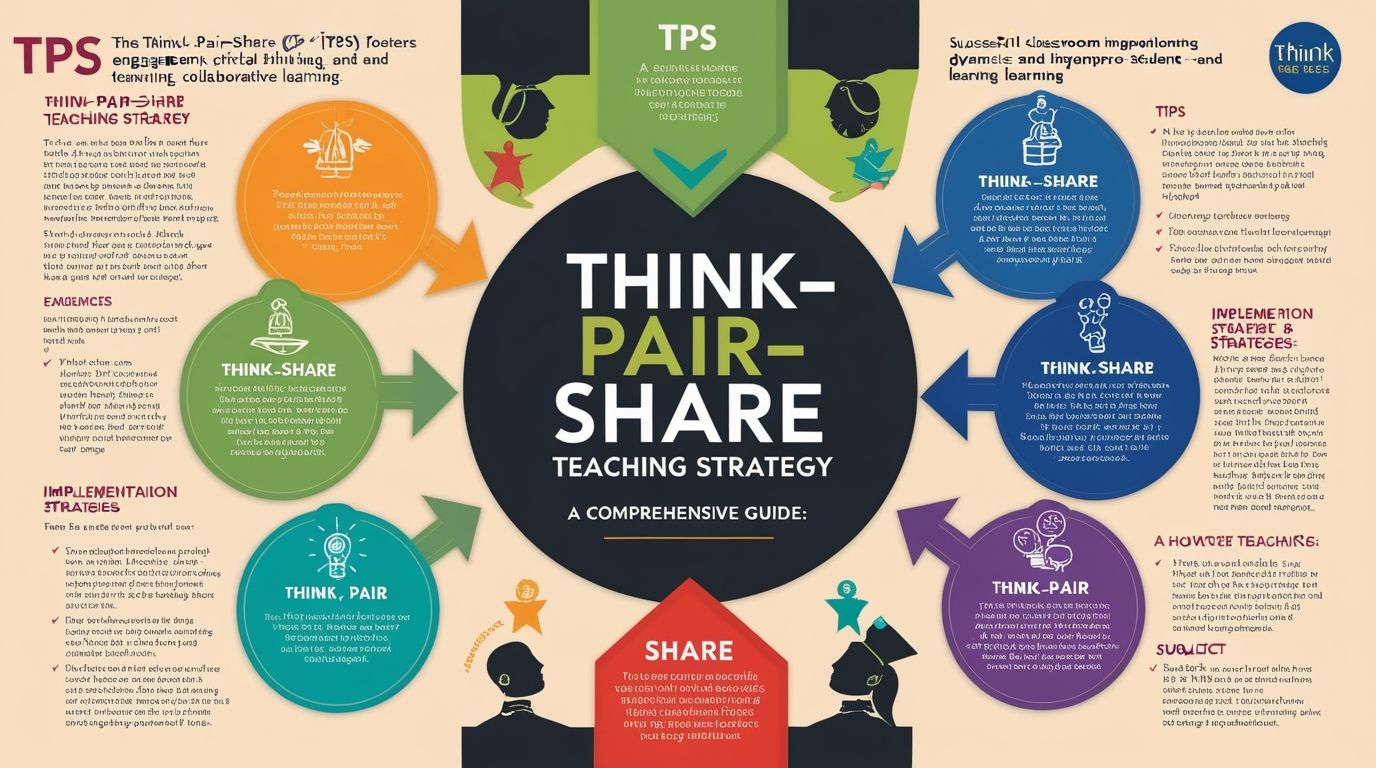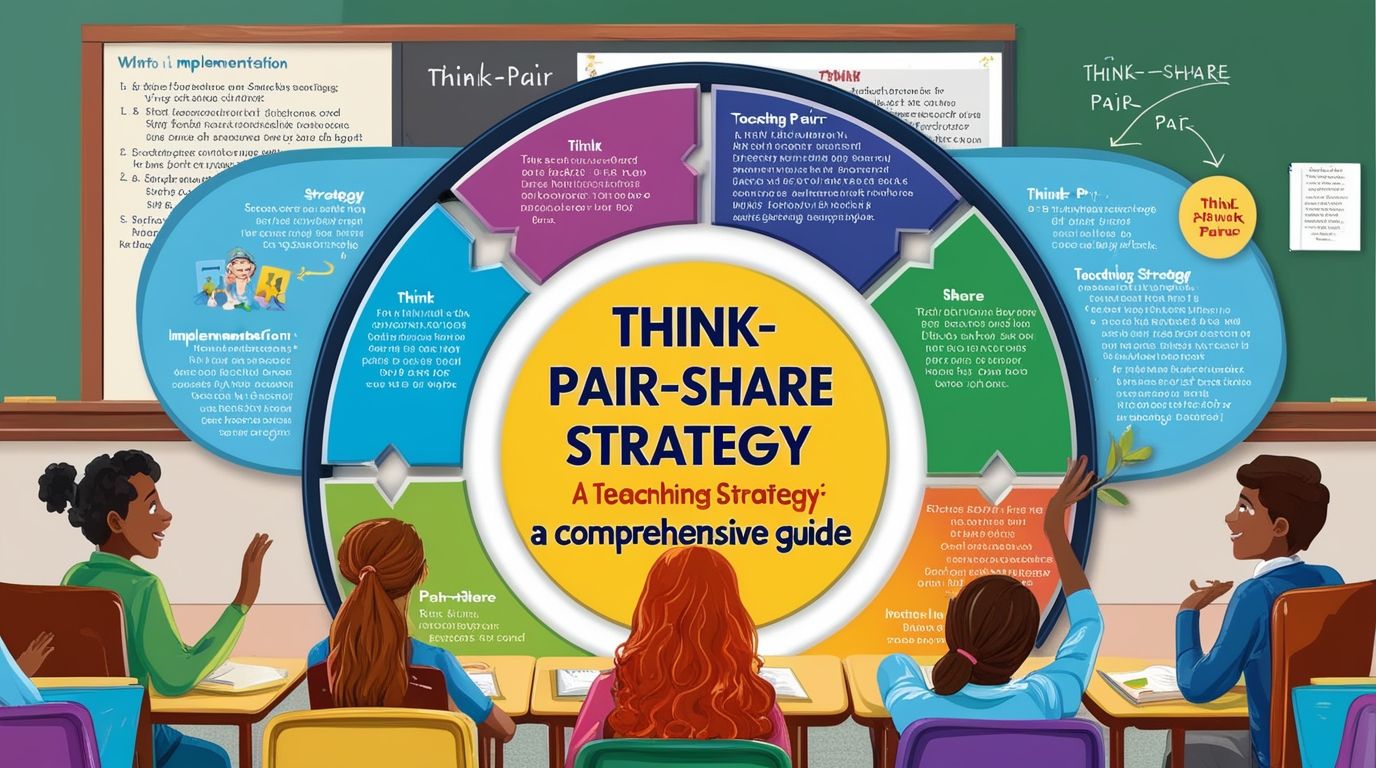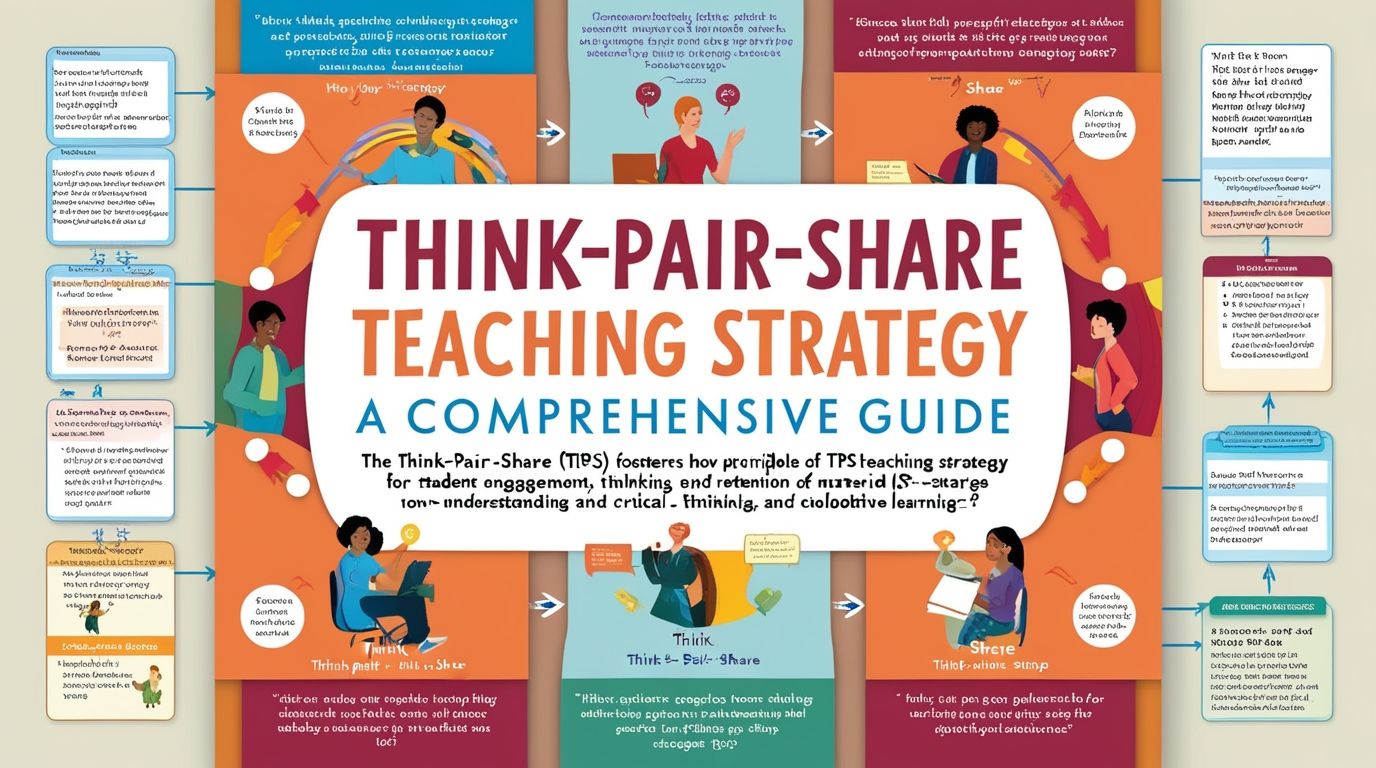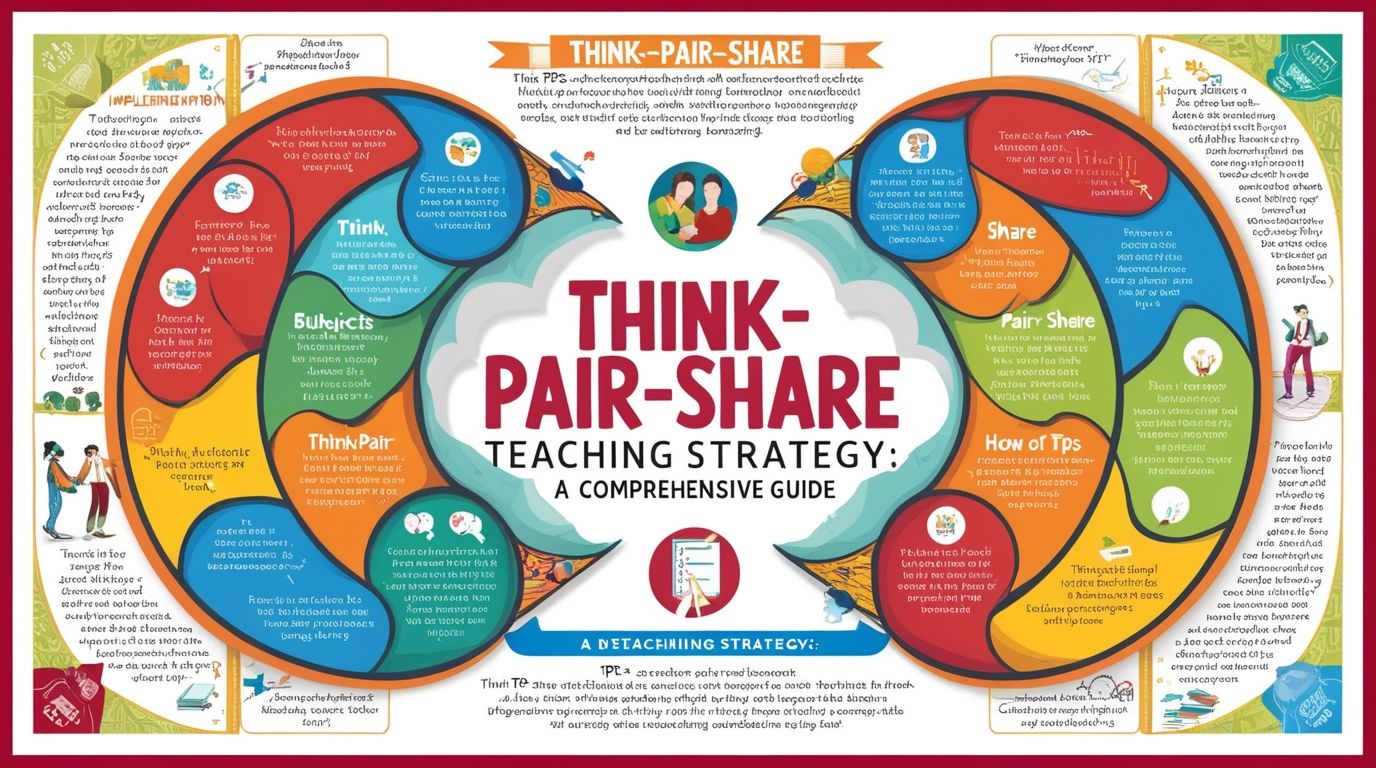Think-Pair-Share (TPS) teaching strategy is an active learning technique that fosters student engagement, critical thinking, and collaborative learning. Developed by Frank Lyman in 1981, TPS is widely used across various educational settings to enhance understanding and retention of material. This comprehensive guide explores the principles behind Think-Pair-Share, its benefits, implementation strategies, practical examples, and tips for overcoming common challenges.
Principles of Think-Pair-Share
Think-Pair-Share is structured around three core stages:
- Think: Students are given a question or prompt and a brief period to think about their responses individually. This stage promotes independent reflection and allows students to formulate their thoughts without pressure.
- Pair: Students then pair up with a partner to discuss their thoughts and ideas. This collaborative phase enables students to articulate their thinking, consider alternative perspectives, and refine their understanding through dialogue.
- Share: Finally, pairs share their insights with the larger group or class. This stage broadens the discussion, allowing for a variety of viewpoints and ideas to be presented and examined.

Benefits of Think-Pair-Share
- Enhanced Engagement: TPS actively involves all students in the learning process. By breaking down the discussion into manageable stages, it ensures that even quieter or less confident students participate and contribute.
- Improved Critical Thinking: The structured stages of TPS require students to reflect on their ideas, engage in meaningful dialogue with peers, and consider diverse perspectives. This process fosters critical thinking and deeper understanding of the material.
- Better Retention: Active participation in the learning process enhances memory retention. By discussing and explaining their thoughts, students reinforce their learning and are more likely to remember the material.
- Development of Communication Skills: TPS helps students develop essential communication skills. Through discussion and sharing, students practice articulating their ideas clearly, listening actively, and engaging in respectful dialogue.
- Inclusivity: TPS creates an inclusive classroom environment where every student’s voice is heard. It promotes equity by ensuring that all students, regardless of their confidence level, have an opportunity to participate.
Implementation Strategies
- Preparation: Effective implementation of TPS begins with careful preparation. Instructors should develop thought-provoking questions or prompts that stimulate critical thinking and discussion. Questions should be open-ended and relevant to the lesson’s objectives.
- Clear Instructions: Providing clear instructions for each stage of TPS is crucial. Students should understand the purpose of the activity and what is expected of them during each phase. Setting a specific time limit for each stage can help maintain focus and ensure the activity progresses smoothly.
- Forming Pairs: Pairing students thoughtfully can enhance the effectiveness of TPS. Instructors can pair students randomly or strategically match students of varying abilities to encourage peer learning. Rotating pairs regularly can also provide students with different perspectives and prevent familiarity from hindering discussion.
- Facilitation: During the pair and share stages, the instructor’s role is to facilitate rather than dominate the discussion. Circulating around the room, listening to pairs, and providing guidance or prompts as needed can help maintain engagement and ensure productive discussions.
- Debriefing: After the share stage, a debriefing session can help consolidate learning. Instructors can summarize key points, highlight interesting insights, and address any misconceptions. Encouraging students to reflect on the activity and discuss what they learned can further reinforce the material.

Practical Examples
Example 1: Literature Analysis
In an English literature class, the instructor uses TPS to analyze a complex poem. First, students are given a few minutes to read the poem silently and think about its themes and literary devices. Next, they pair up to discuss their interpretations, focusing on how the poem’s structure and language contribute to its meaning. Finally, pairs share their insights with the class, leading to a rich, collaborative analysis of the poem.
Example 2: Science Concept Review
In a biology class, the instructor uses TPS to review the concept of photosynthesis. Students first spend a few minutes individually recalling the stages of photosynthesis and jotting down their thoughts. They then pair up to compare their notes and clarify any uncertainties. During the share stage, pairs present their explanations to the class, and the instructor facilitates a discussion to address any remaining questions and reinforce key points.
Example 3: History Debate
In a history class, the instructor uses TPS to explore different perspectives on a historical event. Students are given a question about the causes of the event and spend a few minutes thinking about their response. They then pair up to discuss their viewpoints, considering evidence and arguments from multiple sources. Finally, pairs share their conclusions with the class, leading to a broader debate and deeper understanding of the event’s complexities.

Overcoming Common Challenges
- Time Management: TPS activities can sometimes take longer than anticipated. To address this, instructors should set clear time limits for each stage and use timers to keep the activity on track. Prioritizing key points during the share stage can also help manage time effectively.
- Student Reluctance: Some students may be reluctant to participate in TPS activities, particularly if they are not used to active learning methods. Creating a supportive classroom environment, emphasizing the value of everyone’s contributions, and gradually increasing the complexity of TPS activities can help build student confidence and participation.
- Unequal Participation: In some pairs, one student may dominate the discussion while the other remains passive. Instructors can address this by setting specific guidelines for equal participation, such as alternating who speaks first or assigning roles within pairs. Monitoring pairs and providing gentle prompts can help ensure balanced participation.
- Quality of Discussions: Ensuring that discussions remain focused and productive can be challenging. Instructors can provide guiding questions or prompts to help steer conversations and keep students on track. Periodically checking in with pairs and offering feedback can also enhance the quality of discussions.
Tips for Successful Implementation
- Start Small: For instructors new to TPS, starting with small, low-stakes activities can help build confidence and familiarity with the method. Gradually increasing the complexity and scope of TPS activities can ease the transition and encourage student buy-in.
- Use Varied Prompts: Using a variety of prompts and questions can keep TPS activities fresh and engaging. Mixing up the types of questions—ranging from factual recall to higher-order thinking—can challenge students and cater to different learning styles.
- Incorporate Technology: Technology can enhance TPS activities by providing additional ways for students to think, pair, and share. Online collaboration tools, discussion forums, and audience response systems can facilitate real-time interaction and broaden the scope of TPS.
- Reflect and Adapt: Regularly reflecting on the effectiveness of TPS activities and seeking student feedback can help instructors refine their approach. Being flexible and willing to adapt strategies based on what works best for the class can lead to continuous improvement.
Conclusion
The Think-Pair-Share teaching strategy is a versatile and powerful tool for promoting active learning, critical thinking, and collaboration in the classroom. By structuring activities around the three stages of thinking, pairing, and sharing, instructors can create an inclusive and engaging learning environment where all students have the opportunity to participate and contribute. With thoughtful preparation, clear instructions, and ongoing reflection, TPS can enhance learning outcomes and transform classroom dynamics, making education a more interactive and enriching experience for students.

stbg7l
bg5g1m
u0iky0
g1m9u1
obviously like your web-site but you have to check the spelling on quite a few of your posts. Several of them are rife with spelling problems and I find it very troublesome to tell the truth nevertheless I’ll surely come back again.
Great goods from you, man. I have keep in mind your stuff prior to and you are just too great. I really like what you have acquired right here, really like what you are saying and the best way by which you are saying it. You make it entertaining and you still care for to keep it wise. I can not wait to learn much more from you. This is actually a tremendous website.
Only a smiling visitor here to share the love (:, btw great design and style. “Better by far you should forget and smile than that you should remember and be sad.” by Christina Georgina Rossetti.
I like what you guys are up too. Such clever work and reporting! Keep up the excellent works guys I have incorporated you guys to my blogroll. I think it’ll improve the value of my website 🙂
I like this post, enjoyed this one regards for posting. “Pain is inevitable. Suffering is optional.” by M. Kathleen Casey.
Thank you for sharing excellent informations. Your web-site is so cool. I’m impressed by the details that you have on this blog. It reveals how nicely you perceive this subject. Bookmarked this web page, will come back for extra articles. You, my friend, ROCK! I found just the info I already searched everywhere and simply could not come across. What a perfect website.
This all-in-one clock radio CD player is more than just an alarm—it’s a full media hub. Along with a traditional CD player, it features AM/FM radio, Bluetooth connectivity, and a wireless remote control. Dual alarms make it easy to set different wake times, while the large LED display ensures easy readability. With rich stereo sound and multiple playback options, it’s one of the best clock radios with CD player and Bluetooth functionality. Great for music lovers who value versatility in a radio alarm clock CD player setup.
Rediscover your CD collection with this top-rated clock radio and CD player combo. Ideal for bedrooms, offices, or kitchens, it plays your favorite CDs while also offering a reliable alarm clock radio function. Dual alarms let you set separate wake-up times, and the clear digital display is easy to read day or night. With its stereo radio alarm clock capabilities and optional remote control, this CD alarm clock radio ensures comfort, convenience, and crisp audio in one stylish package. A top choice for those wanting the best CD alarm clock for sound and function.
The very heart of your writing while appearing reasonable at first, did not sit perfectly with me personally after some time. Somewhere within the paragraphs you actually managed to make me a believer unfortunately just for a while. I nevertheless have got a problem with your jumps in logic and you might do nicely to help fill in all those gaps. When you can accomplish that, I will definitely be fascinated.
Hello. excellent job. I did not anticipate this. This is a splendid story. Thanks!
Hi there terrific website! Does running a blog like
this require a great deal of work? I have virtually no understanding of coding
but I was hoping to start my own blog soon. Anyway, if you have any suggestions or techniques for new
blog owners please share. I understand this is off topic but I just needed to
ask. Many thanks!
Feel free to surf to my blog post; nordvpn coupons inspiresensation (t.co)
Howdy! Do you know if they make any plugins to assist with SEO? I’m trying to get my blog to rank for some targeted keywords but I’m not seeing very good success. If you know of any please share. Thank you!
I’ve been browsing online more than three hours lately, yet I never found any interesting article like yours. It’s pretty worth enough for me. In my view, if all website owners and bloggers made excellent content as you probably did, the net will likely be much more helpful than ever before. “Dignity is not negotiable. Dignity is the honor of the family.” by Vartan Gregorian.
incrível este conteúdo. Gostei muito. Aproveitem e vejam este conteúdo. informações, novidades e muito mais. Não deixem de acessar para descobrir mais. Obrigado a todos e até a próxima. 🙂
Outstanding post, you have pointed out some superb details , I as well believe this s a very great website.
Hi, Neat post. There’s an issue with your web site in internet explorer, would check this?K IE still is the market chief and a huge section of other folks will omit your fantastic writing due to this problem.
Do you have any video of that? I’d want to find out some additional information.
I loved as much as you will receive carried out right here.
The sketch is tasteful, your authored material stylish.
nonetheless, you command get bought an edginess
over that you wish be delivering the following. unwell unquestionably come further formerly again since exactly the same nearly
a lot often inside case you shield this increase.
Amazing blog! Do you have any tips for aspiring writers?
I’m hoping to start my own website soon but I’m a little lost on everything.
Would you recommend starting with a free platform like WordPress or
go for a paid option? There are so many choices out there that I’m totally overwhelmed ..
Any recommendations? Bless you!
Great beat ! I wish to apprentice while you amend your site, how could i subscribe for a blog site? The account aided me a acceptable deal. I had been a little bit acquainted of this your broadcast offered bright clear concept
Fantastic items from you, man. I’ve take note your stuff previous to and you’re simply extremely fantastic. I actually like what you’ve obtained here, certainly like what you’re stating and the way in which you are saying it. You are making it entertaining and you continue to care for to keep it sensible. I can not wait to learn far more from you. This is actually a terrific web site.
Wow, marvelous blog layout! How long have you been blogging for? you make blogging look easy. The overall look of your website is magnificent, as well as the content!
Hello there! This is my first visit to your blog!
We are a group of volunteers and starting a new project in a community in the same niche.
Your blog provided us beneficial information to work on.
You have done a wonderful job!
I love it when people come together and share opinions, great blog, keep it up.
This post really stands out in its ability to be thorough without feeling overwhelming. That’s a hard line to walk.
Hi there I am so happy I found your blog, I really found you by error, while I was browsing on Google for something else, Anyways I am here now and would just like to say many thanks for a fantastic post and a all round interesting blog (I also love the theme/design), I don’t have time to read it all at the moment but I have saved it and also added in your RSS feeds, so when I have time I will be back to read a lot more, Please do keep up the great work.
I don’t even know the way I ended up right here, but I thought this post was once good. I do not know who you are but certainly you are going to a famous blogger in case you are not already 😉 Cheers!
I have read some just right stuff here. Certainly worth bookmarking for revisiting. I surprise how so much attempt you set to create the sort of excellent informative site.
I love the efforts you have put in this, thank you for all the great content.
Good post. I learn something new and challenging on blogs I stumbleupon everyday.
It’s always useful to read content from other writers and use a
little something from other web sites.
I’ve been absent for some time, but now I remember why I used to love this website. Thanks, I will try and check back more frequently. How frequently you update your website?
I like this site very much, Its a real nice position to read and receive info . “It is impossible for a man to learn what he thinks he already knows.” by Epictetus.
Heya i am for the primary time here. I came across this board and I to find It truly useful & it helped me out much. I’m hoping to give something again and help others like you aided me.
You have brought up a very wonderful details , thankyou for the post.
I love your blog.. very nice colors & theme. Did you create this website yourself? Plz reply back as I’m looking to create my own blog and would like to know wheere u got this from. thanks
obviously like your web-site but you have to take a look at the spelling on quite a few of your posts. Many of them are rife with spelling problems and I find it very troublesome to inform the truth however I’ll certainly come again again.
Hello there I am so delighted I found your site, I really found you by accident, while I was looking on Google for something else, Anyhow I am here now and would just like to say thanks for a marvelous post and a all round enjoyable blog (I also love the theme/design), I don’t have time to read through it all at the moment but I have saved it and also included your RSS feeds, so when I have time I will be back to read a lot more, Please do keep up the awesome job.
Very interesting information!Perfect just what I was looking for!
whoah this blog is excellent i love reading your articles. Keep up the good work! You know, a lot of people are hunting around for this info, you could help them greatly.
I would like to thnkx for the efforts you have put in writing this blog. I am hoping the same high-grade blog post from you in the upcoming as well. In fact your creative writing abilities has inspired me to get my own blog now. Really the blogging is spreading its wings quickly. Your write up is a good example of it.
Thanks in favor of sharing such a good thinking, post is fastidious, thats why
i have read it completely
I like this blog its a master peace ! Glad I observed this on google .
Perfectly pent written content, thankyou for selective information.
I regard something really interesting about your website so I saved to my bookmarks.
Thank you for any other fantastic article. Where else could anyone get that type of info in such an ideal method of writing? I have a presentation next week, and I’m at the look for such info.
Hey there! I could have sworn I’ve been to this site before but after checking through some of the post I realized it’s new to me. Anyhow, I’m definitely happy I found it and I’ll be bookmarking and checking back frequently!
Have you ever considered publishing an ebook or guest authoring on other blogs? I have a blog centered on the same subjects you discuss and would really like to have you share some stories/information. I know my subscribers would enjoy your work. If you are even remotely interested, feel free to shoot me an e mail.
Howdy! I’m at work browsing your blog from my new iphone!
Just wanted to say I love reading through your blog and look forward to all your
posts! Carry on the superb work!
Feel free to visit my homepage – buy xanax without prescrition
I have not checked in here for some time as I thought it was getting boring, but the last few posts are great quality so I guess I¦ll add you back to my everyday bloglist. You deserve it my friend 🙂
Hi, just required you to know I he added your site to my Google bookmarks due to your layout. But seriously, I believe your internet site has 1 in the freshest theme I??ve came across. It extremely helps make reading your blog significantly easier.
Dead pent subject matter, regards for information. “The earth was made round so we would not see too far down the road.” by Karen Blixen.
Very well written, thanks!
Find adult content by exploring trusted adult platforms online viagra pharmacy.
Discover safe sites for a private experience.